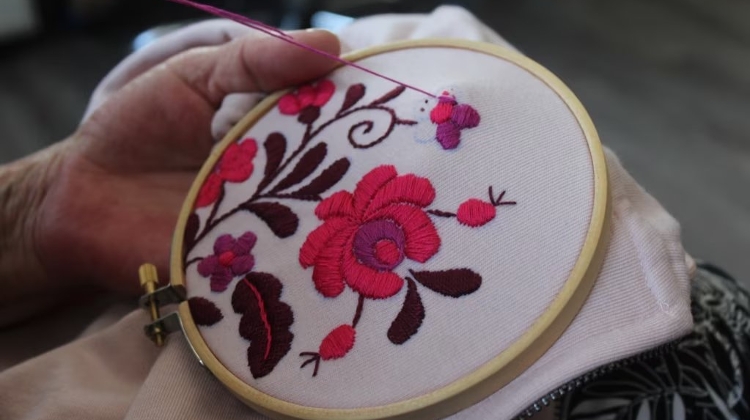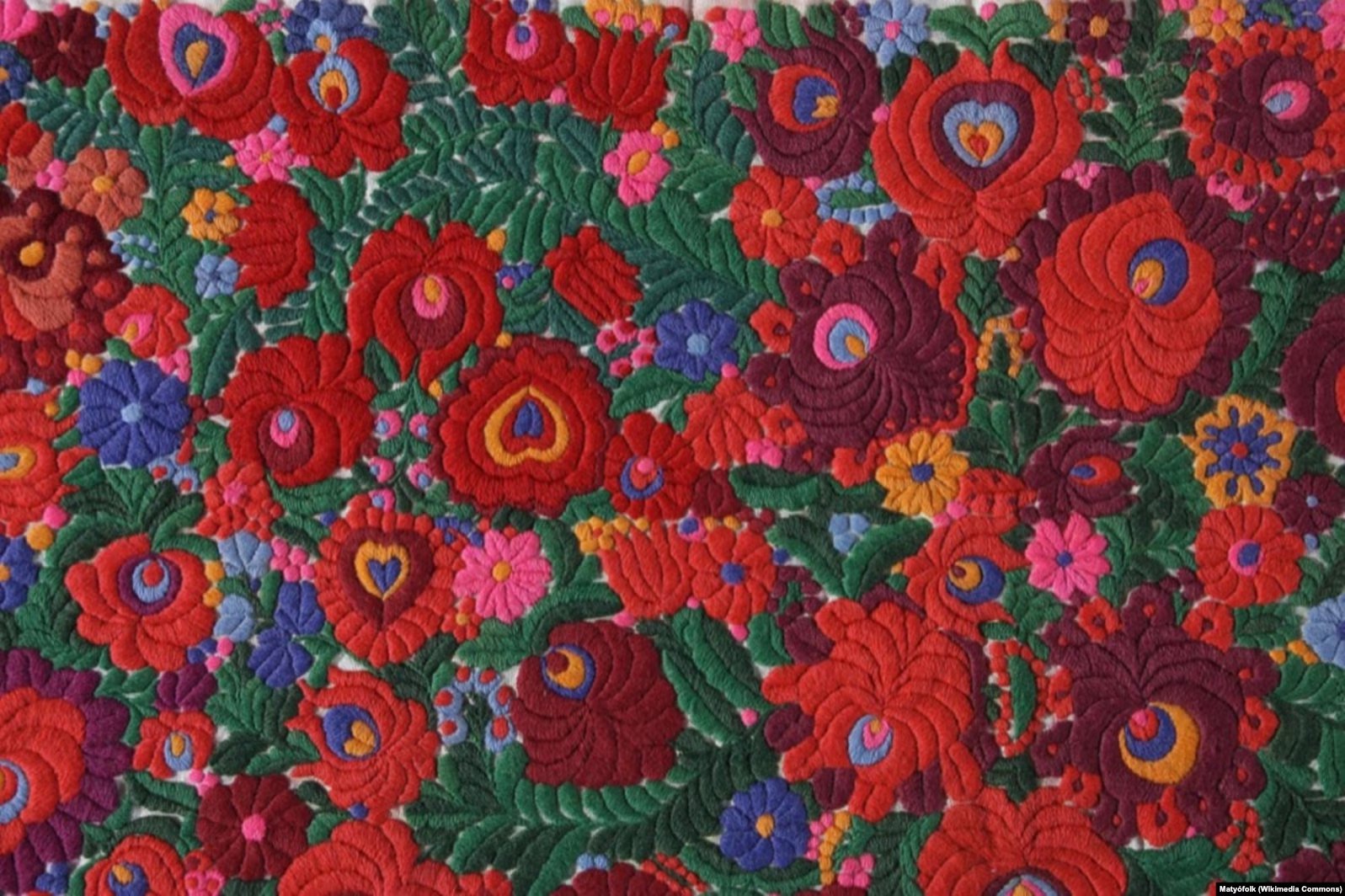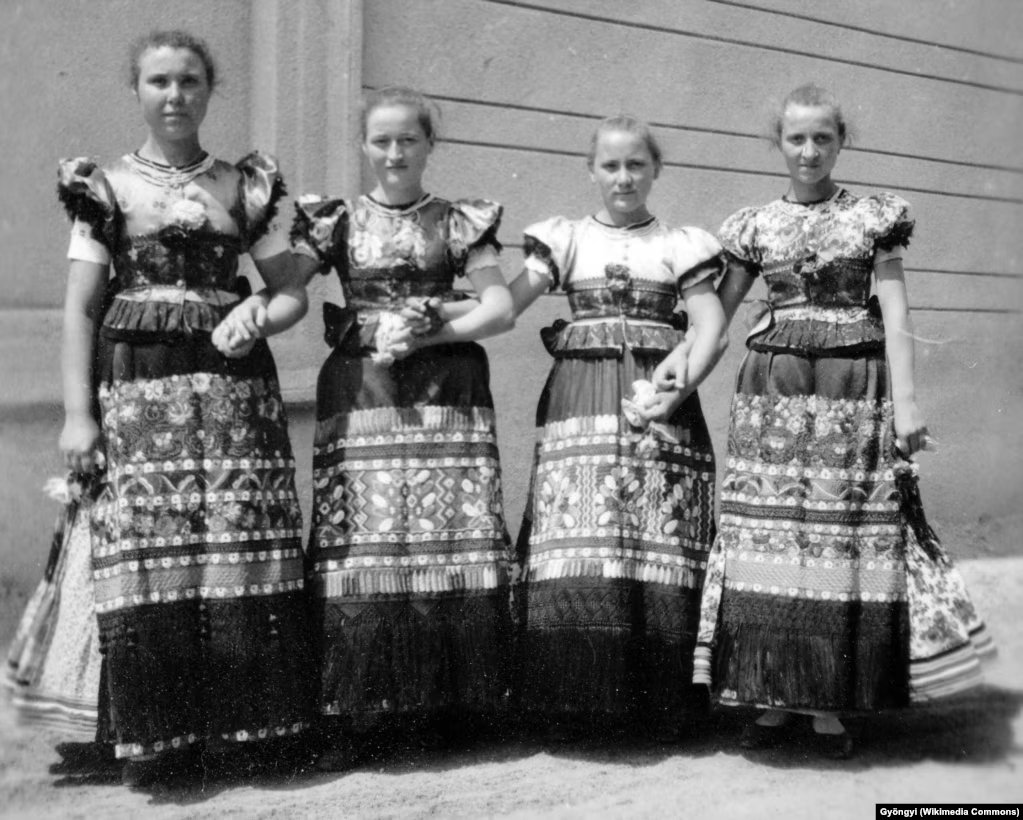In Rural Hungary, Traditional Matyó Embroidery Is An Economic Lifeline
- 16 Aug 2023 3:35 PM

Located on a quiet residential street in Tard, a village of around 1,000 people in northeastern Hungary, the unassuming house is home to a booming embroidery business, which produces high-fashion pieces for international customers and luxury stores.
In this part of Hungary -- wedged between the outer edge of the Carpathian Mountains and the Great Hungarian Plain -- Matyo, a folk-art embroidery traditionally found on the clothing and other textiles of the Matyo people, has been practiced for centuries.
Along with vast fields, limestone caves, and wineries, the vibrant colors and floral motifs of Matyo is one of the region's treasures and has been listed on the UNESCO cultural heritage list since 2012.
"[The embroidery] is a good [thing to do]. It is resting, calming," says Miklos Vajda, or Neni, as the locals call her. Neni, 67, is one of the 45 women working with MatyoDesign and, as she speaks, she makes intricate stitches on a piece of fabric.
"I do it after I've done some hoeing in my garden," she says.

But for Neni and her co-workers, the embroidery is not just for pleasure -- it's a lifeline in an economically deprived area at a time when rampant inflation has taken a sizable chunk out of people's pensions.
The county Tard is in, Borsod-Abauj-Zemplen, is one of Hungary's poorest. Out of 19 counties, it has the country's third-lowest average net monthly pay and the second-highest unemployment rate: 7.8 percent compared to a nationwide average of 4.1 percent.
Depending on the size of the piece, MatyoDesign workers earn from 1,000 forints to 50,000 forints ($3-$140) per pattern, which they say is a welcome addition to their pensions.
"[Without the embroidery,] we don't have any savings," Neni says. "We're happy if we can make it through the month."
While all of its workers embroider from home, MatyoDesign's headquarters -- part office, part workshop -- accommodate several people who sew the clothes, design the patterns, and manage the production.
In the office of founder Rozi Vaczi, there are neat piles of embroidered textiles, newspaper clippings with pictures of models wearing MatyoDesign pieces, and photos of the company's elderly women, who form the core of the workforce.
Forty-three-year-old Vaczi has known some of the women in the photos for decades after spending her early childhood in Tard, before moving to the capital, Budapest, with her teacher parents and four siblings.
Two of those women are in Vaczi's office, both wearing the traditionally embroidered clothes. Neni is the daughter of Vaczi's childhood nanny. Sitting beside her is Maria Hajdue, Neni's cousin who also took care of Vaczi as a child, and is known simply as Dada, the Hungarian word for nanny. She feels a responsibility for her staff, Vaczi says, and is glad that they can now afford to buy medicine, food, or stock up on wood.
The practice of Matyo embroidery is thought to have started around 200 years ago and has since been passed down through the generations. The women living in Tard mastered their skills, embroidering the distinctive flowers and leaves, by watching their mothers, who had learned it from their own mothers.
According to local mythology, the technique was born when the devil kidnapped a man and asked for the most colorful flowers as a ransom. In the dead of winter, in order to get her husband back, his young bride presented the devil with a set of richly embroidered flowers.
For impoverished peasants living in the 19th century, their Matyo garments were lovingly cared for and saved for special occasions. As one local saying goes: "Let the stomach growl, but the costume shine."

Tard used to be a vibrant place, with bustling streets and six local pubs. Vaczi remembers the village being full of children playing, with livestock grazing in people's yards, and neighbors cooking together. In the communist era, many locals worked on collective farms -- ubiquitous across the Eastern Bloc -- or would go further afield to work in the region's factories, metal plants, or mines.
Neni and Dada, who were both born and raised in Tard, took local jobs: Neni worked in a factory; Dada, among other places, worked in a nursery, a hospital, and a morgue.
Like many towns and villages in Hungary's northeast, Tard has been in decline since the wider regional collapse of heavy industry and mining after the fall of communism. Across Hungary, some 1.9 million people -- 12 percent of the population -- now live in poverty. According to 2019 statistics, 15 percent of people over the age of 65 lived in deprivation.
These days, the village is eerily quiet, with neat houses and empty streets. Many young people have left the village to study, work, or just to live in a bigger, livelier place.
Between 2011 and 2021, 12 percent of the working-age population left Borsod-Abauj-Zemplen County, the highest proportion in the entire country -- and that number is likely significantly higher among the aging population of Tard.
The village now has just "one and a half" stores, the half due to its irregular opening hours. With inflation averaging between 20 and 25 percent for the first half of the year, locals often go to buy medicine and groceries in the nearby town of Mezokovesd, where the prices are cheaper in the big foreign supermarkets such as Lidl or Tesco. The price hikes for food have been even higher, with rises of up to 45 percent in 2022.
Rampant inflation is not just a recent phenomenon. After Hungary's first free elections in May 1990, inflation nationwide peaked in 1991 at 35 percent and remained above 20 percent until 1993.
"Financially, I had never in my life been so afraid," Neni says, recalling living through those times. "I said: 'If we get through this, we will survive.' But our situation looked beyond hope. Everything was shutting down, and people were laid off."
With the collapse of much of the region's industry and the end of the state policy of full employment, many locals chose to stay in education for longer or took early retirement. The unemployment rate remained over 10 percent until 1997, a height it only reached again following the 2008 global economic crisis.
The sustained economic decline has led to an increase in crime in the region. According to the most recent statistics, the number of crimes committed in the county is second only to Pest, the eastern part of the capital, which has twice as many inhabitants.
And as of 2022, Borsod-Abauj-Zemplen had the lowest life expectancy in Hungary -- 70 for men and 77 for women -- compared to a countrywide average of 72 and 79.
"Evidently, you only speak to women, as the men have all died," says Marton Gerloczy, who is the brother of MatyoDesign founder Vaczi and a renowned Hungarian writer who moved to Tard during the pandemic.
The nearest town, Mezokovesd, is much like many other Hungarian towns, with small buildings and family houses in the center and factories operating on the outskirts.
There are a few cobblestoned streets in the center, with bakeries, cafes, and restaurants, but the faded billboards and shuttered shops are reminders of the economic hardship.
"Many people move abroad" to work, says a shopkeeper in Mezokovesd, where she was born and grew up. Not wanting to give her name, she says that all of her friends have family members who left, mainly to the United Kingdom, Germany, or Austria.
And while many rely on friends or spouses who are already working there, some people, she says, "just leave."
Two young women -- 20-year-old Eniko Molnar and 22-year-old Anna Vereb -- are sitting on a bench in Mezokovesd, under lush green trees near the monument to Hungary's 1848-49 revolution and war of independence.
Both of the women are from Tard. It was a "good" place to grow up, they say, "but it could have been better," especially the nightlife. "But it's safe. There are no dangerous people or areas. And it's beautiful."
Molnar went to school in Tard, but after the age of 10, she made the 12-kilometer trek to continue her studies in Mezokovesd. Vereb attended school in another local town, Eger. Both are now looking for jobs, but they might end up having to travel or move even further afield.
"In Tard, there are no opportunities," Vereb says. "And neither are there any in Mezokovesd."
They both have parents who travel for work: Molnar's father is a long-distance truck driver and Vereb's mother works in Gyongyos, a town which is an hour away by car, or two hours on the local bus.
Both of the young women know about MatyoDesign.
"I think it's cool that [Vaczi] is doing that in the village, that she is employing the elderly and making Tard more famous. That there is some life, some tourism," Vereb says, referring to the various tourist services that MatyoDesign also offers, including embroidery and cooking courses.
"My goal is to give the women who can't leave [the village] work," Vaczi says. "Many of them have ill children, can't walk, give birth, and have to stay at home. Now they can earn money from home. And also, I believe that this familiar atmosphere makes it easier for them to work."
Vaczi says she is also trying to pay her workers a decent living wage. While in Mezokovesd a typical factory used to pay 80 forints ($0.20) for a small piece of embroidery, she multiplied those wages by five, she says, paying the equivalent of a dollar.
"And ever since," she says, "whenever we are doing better financially, I raise the pay for [each piece of] embroidery."
The European Union and Hungary's Investment Into The Future program gave 62.51 million forints ($177,000) to renovate MatyoDesign's premises, a contribution that is advertised on a sign on the fence outside. Apart from that funding, MatyoDesign was built from the ground up using Vaczi's resources and has caused her many sleepless nights, she says.
The company, she notes, is currently doing well for orders following an article in a German lifestyle magazine.
"I want to keep the Matyo culture alive so that it's happily worn by both old and young people in Hungary and around the world," Vaczi says.
Did she inspire other businesses, perhaps in other areas?
"I think so," Vaczi says. "But to make it work, you need someone who is in love with the project. Someone who doesn't give up at the first setback. Someone who is very dedicated."
While MatyoDesign has reinvigorated part of the local community, the company
might not find many customers among Tard's elderly. T-shirts cost 15,900 forints ($45) and dresses up to 99,000 forints ($280). For the embroiderers of Tard, there are other priorities: food and wood for the cold winter ahead and, if there's any money left, the opportunity to put a little aside.
Source: Radio Free Europe/Radio Liberty - republished with permission

























LATEST NEWS IN entertainment